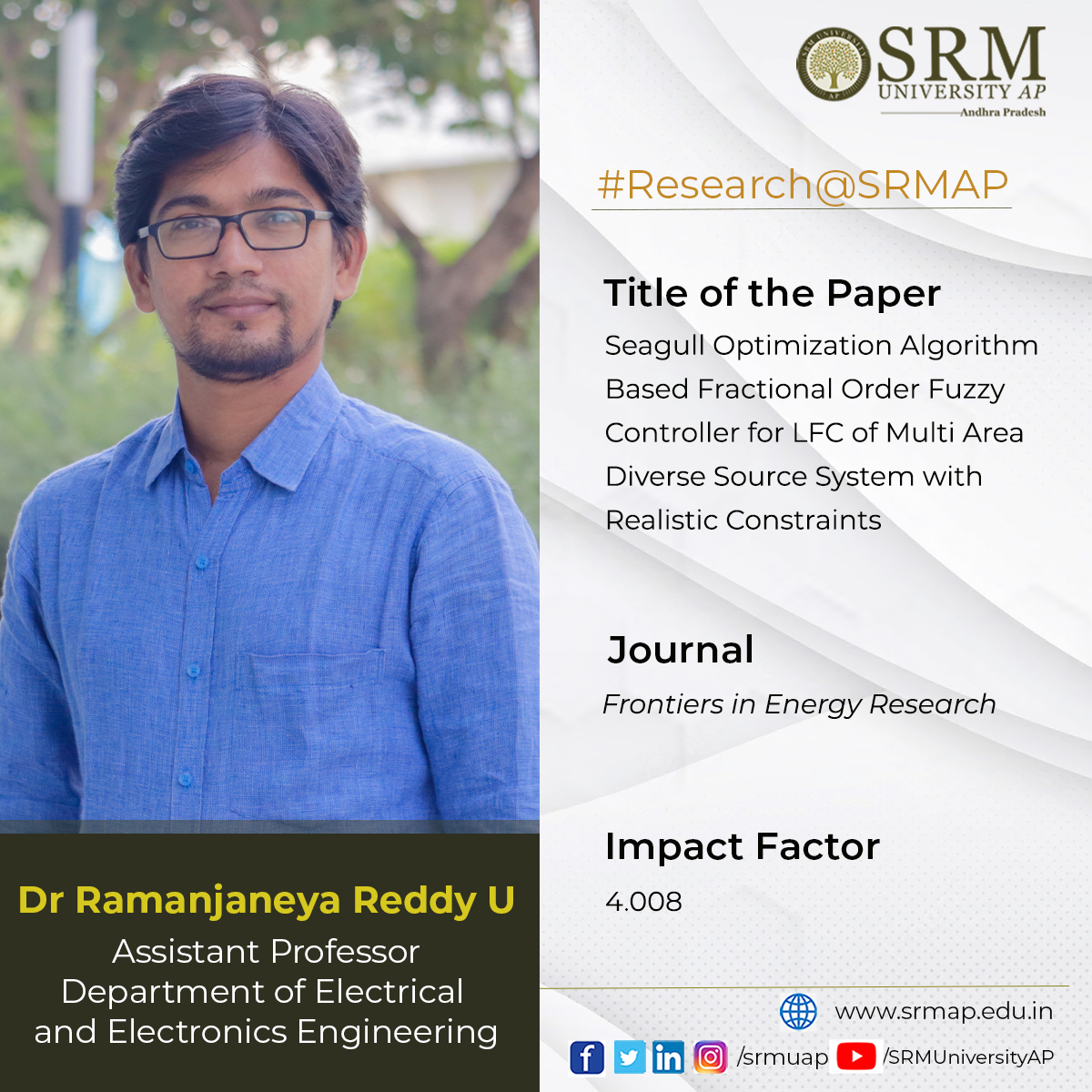 In modern days, the most potent ancillary service is the LFC, especially for controlling and operating interconnected power system networks. The electrical system is becoming more complex due to the integration of several diverse sources generating units to meet the variable load demand. Research in the Department of Electrical and Electronics Engineering is currently working on this area. Assistant Professor Dr Ramanjaneya Reddy recently published a paper titled Seagull Optimization Algorithm Based Fractional Order Fuzzy Controller for LFC of Multi Area Diverse Source System with Realistic Constraints in the Frontiers in Energy Research journal. It is published in the Smart Grids section of the journal with an impact factor of 4.008.
In modern days, the most potent ancillary service is the LFC, especially for controlling and operating interconnected power system networks. The electrical system is becoming more complex due to the integration of several diverse sources generating units to meet the variable load demand. Research in the Department of Electrical and Electronics Engineering is currently working on this area. Assistant Professor Dr Ramanjaneya Reddy recently published a paper titled Seagull Optimization Algorithm Based Fractional Order Fuzzy Controller for LFC of Multi Area Diverse Source System with Realistic Constraints in the Frontiers in Energy Research journal. It is published in the Smart Grids section of the journal with an impact factor of 4.008.
Abstract
This paper initiates the implementation of fractional order (FO) fuzzy (F) PID (FOFPID) controller fine-tuned using a seagull optimisation algorithm (SOA) for the study of load frequency control (LFC). Initially, the SOA tuned FOFPID regulator is implemented to the widely utilized model of dual area reheat-thermal system (DARTS) named as test system-1 in this work for a perturbation of 10% step load (10%SLP) on area-1. Dynamical analysis of the DARTS system reveals the viability of SOA tuned FOFPID control scheme in regulating frequency deviations effectively compared to other control schemes covered in the literature. Later, the presented regulator is implemented in multi-area diverse sources (MADS) system possessing realistic constraints in this paper termed test system-2. The sovereignty of the presented FOFPID controller is once again evidenced with controllers of PID/FOPID/FPID fine-tuned with the SOA approach. Moreover, the effect of considering practical realistic non-linearity constraints such as communication time delays (CTDs) on MADS system performance is visualized, and the necessity of its consideration is demonstrated. Further, AC-DC lines are incorporated with MADS system to enhance the performance under heavy load disturbances and the robustness of the proposed regulatory mechanism is deliberated.
Explanation of the research
The operating point of the generation unit must be altered to keep the real power mismatch (RPM) as minimum as possible. RPM is the exact difference between the amount of real power generated by the generation units and the existing load demand. This RPM is the direct analogy to one of the power full parameters in the interconnected network, frequency. Thus, the minimisation of RPM should be monitored continuously as there will be continuous fluctuations in load demand. This must be done automatically. Otherwise, the real power mismatch may worsen and affect the power system frequency. Frequency regulation must be made with the utmost care; if not, it adversely affects the power system stability. LFC will quickly and automatically accomplish this task.
From the literature on LFC, it is apparent that the optimisation-based controllers significantly handle LFC performance. Hence, applications of new optimisation algorithms for solving realistic power system problems are always welcome. In this regard, this paper implements a new nature-inspired seagull optimisation approach (SOA) algorithm. It is a maiden attempt, especially for power system operation and control of IPS with practical constraints. Until now, the regulators presented by the researchers are tested on linearised and non-linearised power system models without and with integrating renewable energy units. To authenticate the investigative analysis of LFC closer to the nature of the realistic practice, the researchers must adopt the non-linearity constraints with power system models. Constraints of non-linearity like GRC and GDB are considered widely by the researchers and paid less attention to other constraints of CTDs.
In realistic practice, IPS are widely spread and employs numerous sensing and phasor measurement devices. The measured data will be transmitted and received among different devices located at distant places via communication peripherals. Exchange of information won’t be done instantly, and a specific time delay exists. The delay might affect the IPS performance; hence, this paper tried to investigate the predominancy of time delays in coordination with the constraint of GRC. Little work is available on studying LFC with CTDs and is restricted up to the implementation of traditional regulators. Thus, this paper addresses the impact of realistic constraint parameter that is CTDs on IPS performance in coordination with GRC under fuzzy aided FO-based regulator based on the newest optimization algorithm.
Practical implementations of the research
This work considered two different power system networks to assess the FOFPID controller performance. One is DARTS, termed test system-1, and the other is MADS, termed test system-2. DARTS model incorporates thermal units of reheat-type turbines in both areas with equal generation capacities. On the other hand, the MADS system that tests system-2 consists of two areas having Thermal-Hydro-Gas units in area-1, and area-2 comprises Thermal-Hydro-Wind units. The participation factor for each source of generation unit is allocated to achieve smooth load distribution and is considered as 0.6225 for thermal, 0.3 for hydro unit, and a factor of 0.075 for gas/wind unit. The required data to build the DARTS system depicted in Figure 1 and MADS system model depicted in Figure 2 are considered from [13] and [35], respectively. The power system models are designed in the (R2016a) version of MATLAB/SIMULINK.
In the future, there is a lot of scope for assessing the effect of CTDs on LFC performance and the implementation of SOA-based FOFPID for optimising IPS in the restructured environment.

